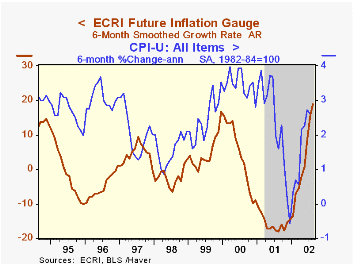 Global| Sep 11 2002
Global| Sep 11 2002ECRI Future Inflation Gauge Rose
by:Tom Moeller
|in:Economy in Brief
Summary
The Future Inflation Gauge (FIG) published by the Economic Cycle Research Institute (ECRI) rose for the fifth consecutive month in August. The indicator's six-month growth rate of 18.8% was the strongest growth rate in the record of [...]

The Future Inflation Gauge (FIG) published by the Economic Cycle Research Institute (ECRI) rose for the fifth consecutive month in August.
The indicator's six-month growth rate of 18.8% was the strongest growth rate in the record of the index which dates back to 1994.
The monthly FIG has a mean lead of 11 months and a median lead of 9 months at inflation cycle turns .
The eight components of the FIG are commodity prices, employment measures, capacity measures, import prices, the yield spread, real estate and debt.
For more on ECRI visit http://www.businesscycle.com.
| ECRI | Aug | July | Y/Y | 2001 | 2000 | 1999 |
|---|---|---|---|---|---|---|
| Future Inflation Gauge | 109.0 | 107.0 | 8.8% | -14.2% | 6.5% | 3.5% |
Tom Moeller
AuthorMore in Author Profile »Prior to joining Haver Analytics in 2000, Mr. Moeller worked as the Economist at Chancellor Capital Management from 1985 to 1999. There, he developed comprehensive economic forecasts and interpreted economic data for equity and fixed income portfolio managers. Also at Chancellor, Mr. Moeller worked as an equity analyst and was responsible for researching and rating companies in the economically sensitive automobile and housing industries for investment in Chancellor’s equity portfolio. Prior to joining Chancellor, Mr. Moeller was an Economist at Citibank from 1979 to 1984. He also analyzed pricing behavior in the metals industry for the Council on Wage and Price Stability in Washington, D.C. In 1999, Mr. Moeller received the award for most accurate forecast from the Forecasters' Club of New York. From 1990 to 1992 he was President of the New York Association for Business Economists. Mr. Moeller earned an M.B.A. in Finance from Fordham University, where he graduated in 1987. He holds a Bachelor of Arts in Economics from George Washington University.






